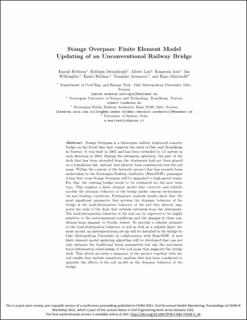| dc.contributor.author | Demirlioglu, Kültigin | |
| dc.contributor.author | Lau, Albert | |
| dc.contributor.author | Martinelli, Enzo | |
| dc.contributor.author | Aziz, Kameran | |
| dc.contributor.author | Willoughby, Ian | |
| dc.contributor.author | Arsenovic, Tomislav | |
| dc.contributor.author | Hylmo, Endre | |
| dc.date.accessioned | 2022-04-05T12:49:57Z | |
| dc.date.available | 2022-04-05T12:49:57Z | |
| dc.date.created | 2022-01-31T20:39:29Z | |
| dc.date.issued | 2021-08-25 | |
| dc.identifier.isbn | 978-3-030-74257-7 | |
| dc.identifier.isbn | 978-3-030-74258-4 | |
| dc.identifier.issn | 2366-2557 | |
| dc.identifier.issn | 2366-2565 | |
| dc.identifier.uri | https://hdl.handle.net/11250/2989969 | |
| dc.description.abstract | Stange Overpass is a three-span railway reinforced concrete bridge on the Dovre line that connects the cities of Oslo and Trondheim in Norway. It was built in 2002 and has been extended by 1,5 meters in each direction in 2004. During the extension operation, the part of the deck that has been extended from the abutments had not been placed on a foundation but, instead, had directly been constructed over the soil mass. Within the context of the Intercity project that has recently been undertaken by the Norwegian Railway Authority (BaneNOR), passenger trains that cross Stange Overpass will be upgraded to high-speed trains. For this, the existing bridge needs to be evaluated for the new train type. This requires a finite element model that correctly and reliably
models the dynamic behavior of the bridge under various environmental and loading conditions. Preliminary analysis results show that the most signi ficant parameter that governs the dynamic behavior of the bridge is the load-deformation behavior of the soil that directly supports the ends of the deck that extends outwards from the abutments. The load-deformation behavior of the soil can be expected to be highly sensitive to the environmental conditions and the changes in these conditions from summer to Nordic winter. To provide a reliable estimate
of the load-deformation behavior of soil as well as a reliable finite element model, an instrumentation set-up will be installed in the bridge by Oslo Metropolitan University in collaboration with BaneNOR. A new fi nite element model updating algorithm will be developed that can not only estimate the traditional linear parameters but also the non-linear force-deformation relationship of the soil mass that supports the bridge deck. This article provides a summary of the project together with initial results that include sensitivity analysis that has been conducted to quantify the effects of the soil model on the dynamic behavior of the bridge. | en_US |
| dc.language.iso | eng | en_US |
| dc.publisher | Springer | en_US |
| dc.relation.ispartofseries | Lecture Notes in Civil Engineering;156 | |
| dc.subject | Acceleration measurements | en_US |
| dc.subject | Finite element model updating | en_US |
| dc.subject | Railway bridges | en_US |
| dc.title | Stange Overpass: Finite Element Model Updating of an Unconventional Railway Bridge | en_US |
| dc.type | Conference object | en_US |
| dc.description.version | acceptedVersion | en_US |
| cristin.ispublished | true | |
| cristin.fulltext | original | |
| cristin.fulltext | original | |
| cristin.qualitycode | 1 | |
| dc.identifier.doi | https://doi.org/10.1007/978-3-030-74258-4_56 | |
| dc.identifier.cristin | 1995712 | |
| dc.source.journal | Lecture Notes in Civil Engineering | en_US |
| dc.source.volume | 156 | en_US |
| dc.source.issue | 156 | en_US |
| dc.source.pagenumber | 13 | en_US |
